Types of heating systems for a private home: comparative review + pros and cons of each type
Your own home is not only a personal fortress, but also a place where it is cozy and warm. For this to always be the case, a prudent owner must provide an uninterrupted supply of heat.The easiest way to do this is if you can connect to a centralized system.
However, this is not always the case, and many do not want to connect to an expensive service. In this case, it remains to consider the types of heating systems suitable for autonomous installation, and then choose the best option. And we will try to help you in this matter - our article discusses the features of water, air and infrared heating systems, listing their main pros and cons.
We have also provided useful recommendations for choosing the best option. The presented material was provided with visual diagrams, photographs and videos with reviews of these heating systems.
The content of the article:
How to choose the best heating system?
There are many heating systems. They all have attractive sides and significant disadvantages. It is quite difficult for an unprepared person to navigate them and make the right choice. In order not to make mistakes, you need to know exactly what points you should pay attention to.
Firstly, it is the availability of fuel and its cost. This can be considered a key point. No matter how much you like the system, if the fuel for it is difficult to obtain, is supplied to the region intermittently, or is too expensive, you should consider another option. Otherwise, heating your home will cost a pretty penny and will be ineffective.
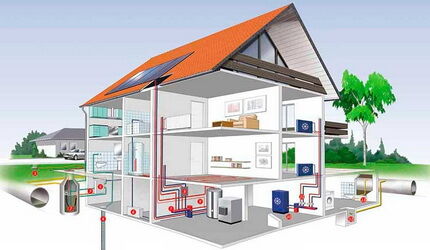
The second point is the possibility of combining heating systems. In some cases, it may be very practical to use a primary and secondary system. This gives confidence that in the event of possible interruptions in energy supplies, the house will not be left without heat.
In addition, there is an opportunity to save money, since you can use the most economical heating method at the moment.
And finally, the financial side of the issue. It is necessary to determine how much the consumer can allocate for the purchase of equipment, its proper installation and subsequent regular maintenance.
Features of a liquid coolant system
Heating systems with coolant in liquid form are perhaps the most popular in our country. This is understandable, because they are familiar and quite effective. The basis of such a system is a closed-type heating circuit with a heating device, inside of which there is a heat exchanger. Liquid passes through it and heats up to the desired temperature.
Next, the coolant goes through the pipes to the heated rooms. Here it enters the radiators, where it gradually cools, giving off heat to the surrounding air. The cooled liquid moves towards the heating device, enters the heat exchanger and the cycle repeats.
Such a system is also called water heating, but this is not entirely correct, since various compounds can be used as a coolant - for example, antifreeze.

The undoubted advantage of such a system can be considered its variability. There are many most different wiring schemes, allowing for the most efficient heat supply for specific conditions.
There are water heating with forced and gravitational circulation. In the first case, a pump is used to supply the coolant, which makes it possible to implement circuits of varying complexity and length. The second option has many limitations, but is completely energy independent.

The system can be configured with one- or two-pipe wiring. The first is extremely simple and economical, but not effective enough for a large house. The second is more complex, but allows high-quality heating of buildings of any size. Depending on the type of system chosen, the set of equipment necessary for its installation also differs.
An integral element of any of them is the boiler, the type of which largely determines the operational characteristics of the system. Let's look at the most popular devices.
Option #1 - using gas equipment
A gas boiler is considered the most economical of all analogues. It works extremely simply. The gas enters the combustion chamber, where it burns, releasing heat, which is transferred to the coolant liquid through a heat exchanger.
The equipment is diverse and, accordingly, has different properties. Turbocharged equipment is considered the safest and most efficient.
It does not require the installation of a traditional chimney, does not take air from the room and has the highest efficiency.
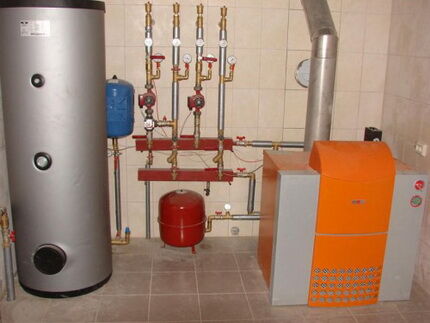
Devices with an open chamber are characterized by low efficiency and require high-quality ventilation and a traditional smoke exhaust system. At the same time, they are completely energy independent, and their cost is minimal. But it's important install correctly and connect the equipment.
The advantages of heating with a gas boiler include the following features:
- Low fuel cost, it increases very slowly.
- High equipment efficiency.
- Possibility of full automation of the heating system.
- Cleanliness in the premises, since fuel combustion does not produce large amounts of ash and soot.
- Wide range of gas equipment.
Among the disadvantages, it is worth noting the potential danger of using gas. Great care is required when working with it. All maintenance and installation work may only be carried out by certified specialists.
In addition, special permission will be required to connect gas equipment. The cost of devices and their installation is quite high; the possibility of connecting to a gas main does not exist everywhere.
Option #2 - use of a solid fuel boiler
These are heating devices familiar to many. Their operation requires solid fuel: calibrated coal, firewood, peat, pellets, etc. The operating principle is similar to gas ones, they differ in the type of burner.
Modern modifications of long-burning are characterized by the fact that one load of fuel is enough to maintain the flame for half a day or more. The simplest models are non-volatile, require constant human control and have low efficiency.
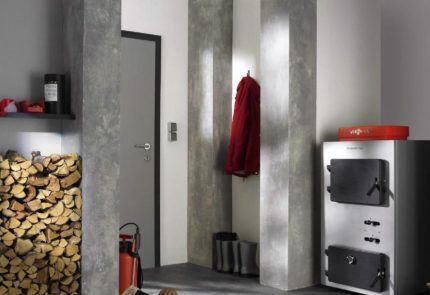
Improved devices can be equipped with automated control and automatic fuel supply. True, the latter applies to pellet equipment. Such devices when connected correctly, are quite effective and reliable.
The advantages of solid fuel equipment are:
- Simplicity and reliability of the design, which significantly extends its service life.
- The budget cost of the equipment and the possibility of carrying out its installation and subsequent maintenance yourself.
- There is no need to obtain special documentation for the installation of such a boiler.
- A wide selection of devices with different functionality and power.
The equipment also has significant disadvantages. First of all, this is the need to create a fuel reserve, which must be stored in proper conditions. Solid fuel boilers, especially their simplest modifications, are not very easy to use. There is a large amount of soot and soot, so very frequent cleaning of the device is required. In addition, you will also have to load fuel quite often.
Option #3 - using an electric boiler
You can also warm up the coolant in the system using electric boilers. It is generally accepted that this is a very uneconomical method. However, this is not quite true. You need to understand that several types of electrical equipment with different characteristics are produced.
Heating element and electrode models
Heating element models are the simplest and most ineffective. They heat the coolant using tubular electric heaters lowered into it. The devices consume a large amount of electricity with a relatively low efficiency. At the same time, the heating elements in the liquid fail quite quickly.
Electrode boilers are more economical and reliable.In them, the coolant moves inside the boiler, where two electrodes are installed. When an electric current is applied, the liquid heats up very quickly.
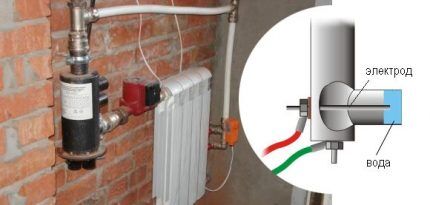
Induction boiler type
The most efficient and economical type of electrical equipment is induction boilers. Thanks to the presence of two circuits, magnetic and thermal, they manage to heat the coolant liquid as quickly as possible.
The advantages of all types of heating devices include:
- Quick heating of the coolant and, accordingly, the room.
- Compact equipment.
- Simple installation, which is carried out without first obtaining permission.
- No chimney installation is required.
- Comfortable operation, possibility of equipping with automatic control.
- Complete safety and environmental friendliness.
Among the disadvantages, the rather high cost of operation is usually noted, which is a consequence of the high price of energy.
True, depending on the type of boiler and the presence or absence of automated system control, heating costs can vary significantly. Induction boilers, fully equipped with automation, are quite economical and pay for themselves quite quickly.
Combined heating boilers
You can find it on sale combined heating boilers, capable of working with several types of fuel. These are more expensive devices, the main advantage of which is the ability to provide the house with heat in conditions of interruptions in the supply of the main type of fuel.
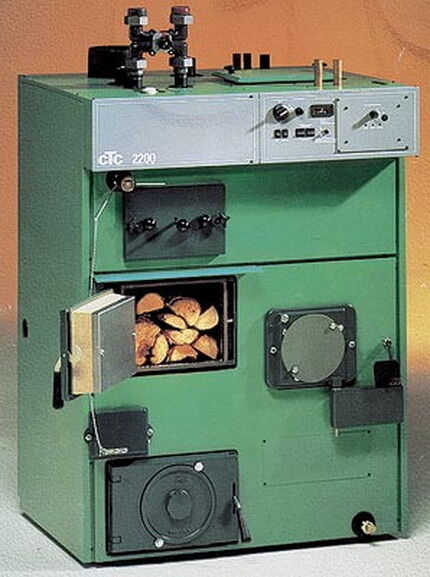
The common advantages of all heating systems with liquid coolant are low cost and availability, fairly high efficiency and many design options.
The disadvantages include not the most comfortable temperature distribution in the rooms. Warm air is at the top and cooler air is at the bottom.
In addition, water systems fail if the temperature in the building drops below freezing. Systems with antifreeze and saline solutions do not have this drawback. However, antifreezes are expensive and toxic, and salt solutions provoke rapid corrosion of the system.
Air heating of the building
This is another type of heating for a private home. Its main distinguishing feature is the lack of coolant. The air system is designed in such a way that air flows pass through a heat generator, where it is heated to the desired temperature.
Then, through special air ducts, which can have very different shapes and sizes, the air masses are directed to the heated rooms.
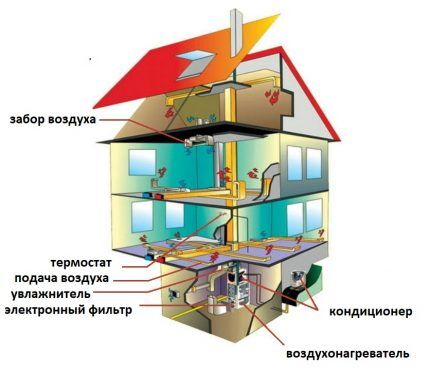
According to the laws of convection, heated flows rise, cooled ones move down, where holes are mounted through which air is collected and removed to the heat generator. The cycle repeats.
Such systems can operate with forced and natural air supply. In the first case, a pump is additionally installed to force the flow inside the air ducts.In the second, air movement occurs due to temperature differences. It is clear that forced circulation systems are more efficient and powerful. We talked about arranging air heating with our own hands in the next article.
Heat generators also differ. They can run on a wide variety of fuels, which determines their performance characteristics. Gas, electric and solid fuel appliances are most in demand. Their disadvantages and advantages are close to similar water heating boilers.
The circulation of air masses inside a building can be carried out in different ways. This can be a closed cycle without adding air from outside. In this case, the indoor air quality is poor.
The best option is circulation with the addition of air masses from outside. An undeniable advantage of air heating is the absence of coolant. Thanks to this, it is possible to save the energy needed to heat it.
In addition, the installation of a complex system of pipes and radiators is not required, which undoubtedly also increases the efficiency of the system. The system does not have the risk of leaks and freezing, like its water counterpart. It is ready to work at any temperature. The living space heats up extremely quickly: literally, about half an hour passes from starting the heat generator to raising the temperature in the rooms.

Another significant plus is the ability to combine air heating with ventilation and air conditioning. This opens up the widest possibilities for creating the most comfortable microclimate in the building.
The air duct system can be successfully used for air conditioning rooms in the summer. Installing additional equipment will make it possible to humidify, purify and even disinfect the air.
Air heating equipment lends itself well to automation. “Smart” control allows you to remove burdensome control over the operation of appliances from the homeowner. In addition, the system will independently select the most economical operating mode. Air heating is very easy to install and durable. Its average service life is about 25 years.
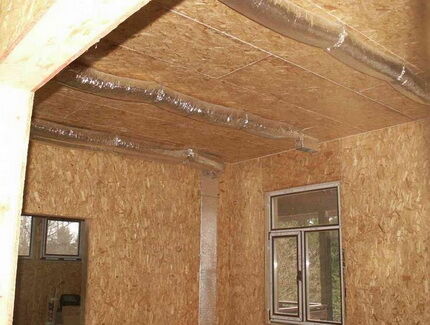
The advantages include the absence of pipes and radiators, which gives room for the imagination of designers who design the interior. The cost of such a system is quite affordable for most homeowners. Moreover, it pays off quite quickly, so its demand is growing.
Air heating also has disadvantages. These include a significant difference between the temperatures in the lower and upper parts of the room. On average it is 10 °C, but in rooms with high ceilings it can reach up to 20 °C. Thus, in the cold season, increased power of the heat generator will be required.
Another disadvantage is the rather noisy operation of the equipment. True, this can be mitigated by selecting special “quiet” devices. If there is no filtration system at the outlets, large amounts of dust may appear in the air.
Infrared heating system
This is a relatively new method of heating residential buildings.It is based on the use of infrared radiation. Scientists have found that infrared rays can have different lengths. Long-wave radiation, similar to what we receive from the Sun, is safe and even beneficial for humans. It is used in heating devices operating in the infrared range.
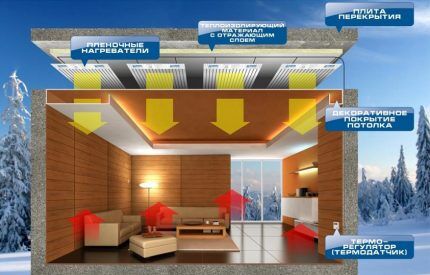
For heating premises, a special infrared film is used. A thin layer of carbon paste is applied to a non-woven base, which is activated under the influence of current and emits infrared waves. The resulting emitter is laminated on both sides with a film, which gives it strength and extends its service life.
The operating principle of infrared heating is as follows. The film is placed on the floor or on the ceiling. When the system is turned on, current is applied to the emitter and it produces infrared waves. They move and reach the first massive obstacle. This can be large furniture, household appliances, and most often the floor. Such objects are impenetrable to infrared rays; they are retained and accumulated in them.
Objects gradually heat up and release the resulting heat into the air, due to this the room warms up very quickly. In another article we talked in more detail about infrared heating device with your own hands.
It must be admitted that this type of heating is the most comfortable. Due to the fact that the floor is heated, the temperature distribution is as pleasant and beneficial for humans as possible. The lower part of the room is about 2-3 °C warmer than the upper part.
In addition, natural humidity and the amount of oxygen are completely preserved, and there are no convection currents that carry dust. There are no drafts either. Film heaters operate absolutely silently and are safe for humans.
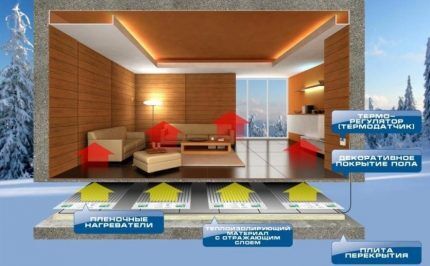
Another advantage is fully automated system control. This allows it to operate in the most economical mode and at the same time provide the owner with complete comfort. Thanks to this, the film system has no heat losses and its efficiency is almost 100%.
The minimum service life of the equipment is 25 years, and the service life is twice as long. In this case, the system does not require maintenance.
The next advantage is compactness. The film is very thin and does not “eat up” the free space. No additional room is required for the heating unit; there are no batteries or air ducts. The film is very easy to install and connect. If necessary, dismantling and reuse is possible.
Among the disadvantages, it is worth noting that as the voltage drops, the amount of heat generated by the film decreases. In this case, the operating time of the heater increases, which leads to greater energy consumption. The film can be covered with a variety of finishing coatings, except putty, wallpaper and paint. The cost of equipment for installing infrared heating is quite high.
Conclusions and useful video on the topic
To heat a private home, different types of heating are used, and sometimes several are combined. You can learn how heating is done from the following videos.
Pros and cons of air heating:
What users say about infrared heating:
Features of arranging water heating with your own hands:
It is technically possible to install almost any heating system in a private home. Therefore, the owner must choose the most practical and most suitable option for the conditions existing in his home. When making a choice, you should listen to the opinions of experts and correctly calculate your heating system. Then your house will be very warm, even if it is severe winter outside.
What heating system do you use? What advantages and disadvantages have you noticed when using your heating system? Or are you still looking around, choosing the best option? Maybe you still have questions after reading this article? Please ask them below - our experts and other site visitors will try to help you.




Water types of heating have always been more profitable, and you can’t argue with me on this. That's why I chose only radiators for my house. The cost of installing such a heating circuit does not break the bank. The main thing is to choose the right heating boiler. We took a dual-circuit one. We are very pleased: there is hot water and warmth in the house. The only disadvantage of such boilers is that they are energy dependent - there is no light, and therefore no heat. But this rarely happens with us.
You need to focus on the type of fuel that is available. And if there are several of them, then choose the cheaper one. I had a small choice - a solid fuel boiler or an electric one. It was, of course, possible to install a boiler using liquefied gas, but I somehow lost sight of this possibility.
I installed a solid fuel boiler, a long-burning model, made a tank for hot water, everything works fine. But preparing fuel for it, purchasing it, or rather, is a hassle every time. In addition, it quickly burns out on briquettes, and coal is an expensive business in our region.
Now I would probably think a lot about a liquefied gas boiler - it’s clean, and a gas station was built nearby.